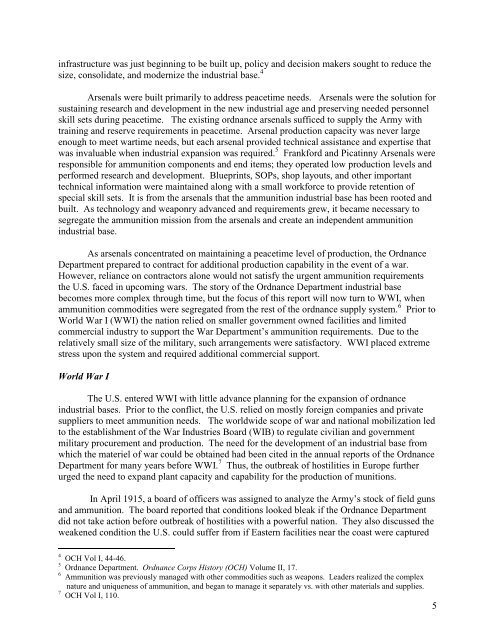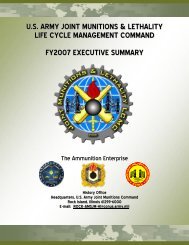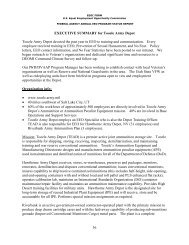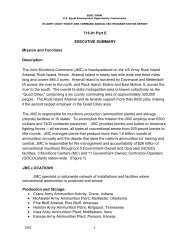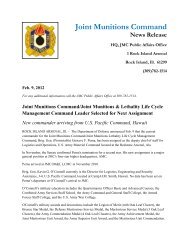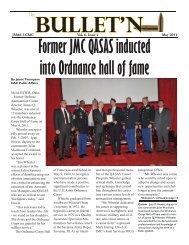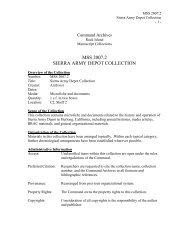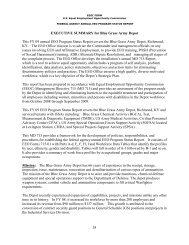History of the Ammunition Industrial Base - JMC - U.S. Army
History of the Ammunition Industrial Base - JMC - U.S. Army
History of the Ammunition Industrial Base - JMC - U.S. Army
You also want an ePaper? Increase the reach of your titles
YUMPU automatically turns print PDFs into web optimized ePapers that Google loves.
infrastructure was just beginning to be built up, policy and decision makers sought to reduce <strong>the</strong><br />
size, consolidate, and modernize <strong>the</strong> industrial base. 4<br />
Arsenals were built primarily to address peacetime needs. Arsenals were <strong>the</strong> solution for<br />
sustaining research and development in <strong>the</strong> new industrial age and preserving needed personnel<br />
skill sets during peacetime. The existing ordnance arsenals sufficed to supply <strong>the</strong> <strong>Army</strong> with<br />
training and reserve requirements in peacetime. Arsenal production capacity was never large<br />
enough to meet wartime needs, but each arsenal provided technical assistance and expertise that<br />
was invaluable when industrial expansion was required. 5 Frankford and Picatinny Arsenals were<br />
responsible for ammunition components and end items; <strong>the</strong>y operated low production levels and<br />
performed research and development. Blueprints, SOPs, shop layouts, and o<strong>the</strong>r important<br />
technical information were maintained along with a small workforce to provide retention <strong>of</strong><br />
special skill sets. It is from <strong>the</strong> arsenals that <strong>the</strong> ammunition industrial base has been rooted and<br />
built. As technology and weaponry advanced and requirements grew, it became necessary to<br />
segregate <strong>the</strong> ammunition mission from <strong>the</strong> arsenals and create an independent ammunition<br />
industrial base.<br />
As arsenals concentrated on maintaining a peacetime level <strong>of</strong> production, <strong>the</strong> Ordnance<br />
Department prepared to contract for additional production capability in <strong>the</strong> event <strong>of</strong> a war.<br />
However, reliance on contractors alone would not satisfy <strong>the</strong> urgent ammunition requirements<br />
<strong>the</strong> U.S. faced in upcoming wars. The story <strong>of</strong> <strong>the</strong> Ordnance Department industrial base<br />
becomes more complex through time, but <strong>the</strong> focus <strong>of</strong> this report will now turn to WWI, when<br />
ammunition commodities were segregated from <strong>the</strong> rest <strong>of</strong> <strong>the</strong> ordnance supply system. 6 Prior to<br />
World War I (WWI) <strong>the</strong> nation relied on smaller government owned facilities and limited<br />
commercial industry to support <strong>the</strong> War Department‟s ammunition requirements. Due to <strong>the</strong><br />
relatively small size <strong>of</strong> <strong>the</strong> military, such arrangements were satisfactory. WWI placed extreme<br />
stress upon <strong>the</strong> system and required additional commercial support.<br />
World War I<br />
The U.S. entered WWI with little advance planning for <strong>the</strong> expansion <strong>of</strong> ordnance<br />
industrial bases. Prior to <strong>the</strong> conflict, <strong>the</strong> U.S. relied on mostly foreign companies and private<br />
suppliers to meet ammunition needs. The worldwide scope <strong>of</strong> war and national mobilization led<br />
to <strong>the</strong> establishment <strong>of</strong> <strong>the</strong> War Industries Board (WIB) to regulate civilian and government<br />
military procurement and production. The need for <strong>the</strong> development <strong>of</strong> an industrial base from<br />
which <strong>the</strong> materiel <strong>of</strong> war could be obtained had been cited in <strong>the</strong> annual reports <strong>of</strong> <strong>the</strong> Ordnance<br />
Department for many years before WWI. 7 Thus, <strong>the</strong> outbreak <strong>of</strong> hostilities in Europe fur<strong>the</strong>r<br />
urged <strong>the</strong> need to expand plant capacity and capability for <strong>the</strong> production <strong>of</strong> munitions.<br />
In April 1915, a board <strong>of</strong> <strong>of</strong>ficers was assigned to analyze <strong>the</strong> <strong>Army</strong>‟s stock <strong>of</strong> field guns<br />
and ammunition. The board reported that conditions looked bleak if <strong>the</strong> Ordnance Department<br />
did not take action before outbreak <strong>of</strong> hostilities with a powerful nation. They also discussed <strong>the</strong><br />
weakened condition <strong>the</strong> U.S. could suffer from if Eastern facilities near <strong>the</strong> coast were captured<br />
4 OCH Vol I, 44-46.<br />
5 Ordnance Department. Ordnance Corps <strong>History</strong> (OCH) Volume II, 17.<br />
6 <strong>Ammunition</strong> was previously managed with o<strong>the</strong>r commodities such as weapons. Leaders realized <strong>the</strong> complex<br />
nature and uniqueness <strong>of</strong> ammunition, and began to manage it separately vs. with o<strong>the</strong>r materials and supplies.<br />
7 OCH Vol I, 110.<br />
5


